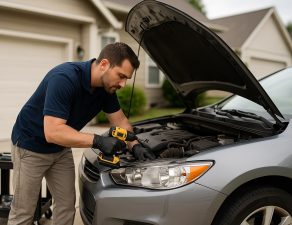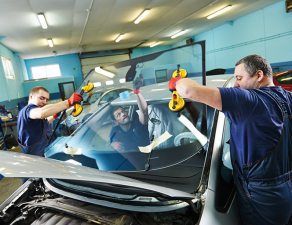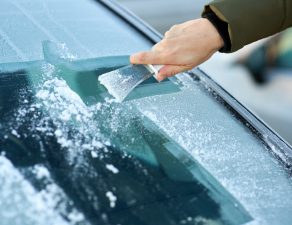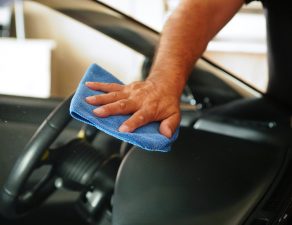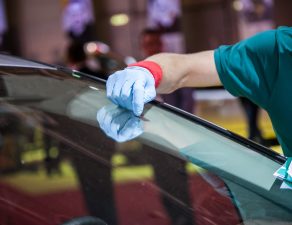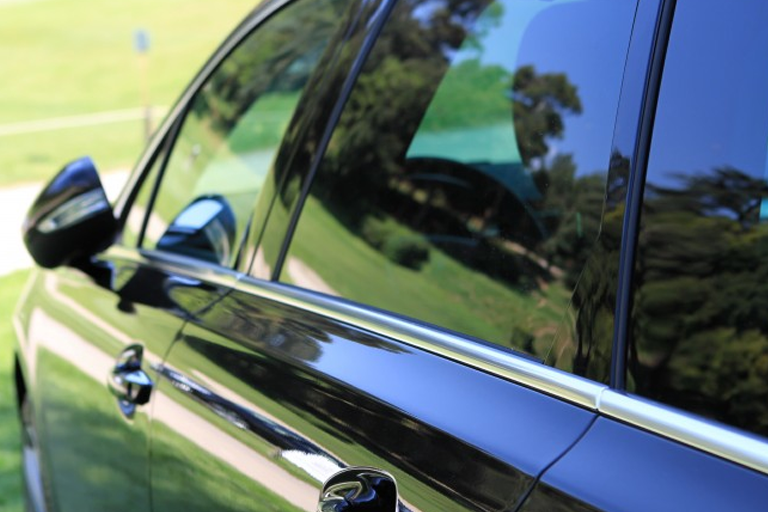
Commonly Asked Questions About Car Windows
How Do Car Windows Protect You?
When it comes to the safety features of your vehicle, your windshield is probably not the first thing that comes to mind. Instead, you probably think of your seat belts, airbags, or the frame of your car.
It may surprise you to learn that your windshield is actually essential to the functionality of your airbags, and the strength of your car frame. Your windshield can even save you from the serious injuries, and even possible death, that occur when you fail to wear your seat belt, or your seat belt doesn’t work properly.
An example of this comes from a news report in May of 2015 from Texas. A 60-year-old woman was lodged and became stuck in her windshield after getting into a car accident. While it may seem odd for this to happen–this is precisely what your windshield was made for, in the event that your seat belt is not properly worn when an accident occurs.
The purpose of your windshield is multifaceted and much more important than you probably know.
How Many Kinds Are There?
Outside of your windshield, your car can have up to 5 additional types of car windows. The windows in your doors are called sidelines.
There are two different types of glass that sidelites can be made out of, which will be covered later in this article. Depending on the type of glass the sidelite is made out of, a series of very precise tools must be used to create the perfect shape for your automobile. This includes diamond wheels, coolant, dressing sticks, diamond belts, silicon carbide belts, cutting wheels, silicon carbide wheels, and diamond pads and files.
The small triangular windows that you (usually) can’t open, positioned near the joints of your car, are called quarter windows. Over time, less and less vehicles have quarter windows built into their design. (Even more infamous and rare are the elusive 1970’s opera windows).
When quarter windows have hinges and a latch, they’re called ventiplanes–because they can be opened for additional ventilation. These are usually found in minivans and some trucks.
Some quarter windows are motorized as well–so people can easily press a button and roll them down.
Your rear window is called the backlite.
What we know as a rear window today, developed over a few decades. The earliest cars had no windows or car glass of any sort. The windshield glass and sidelites were added for comfort and convenience, but the rear window was either mitigated to a small panel near the top of the car’s cabin or omitted from the vehicle altogether.
By 1930, most cars had rear windows similar to what we see today, as it became apparent that being able to assess other drivers on the road was necessary for safety reasons.
Each of these types of windows help to reduce extraneous noise, insulate your vehicle, provide better aerodynamics that improves gas mileage and wind resistance and help keep the frame of your vehicle from crushing inwards in the event of a rollover accident.
Can You Explain Tempered Glass vs. Laminate Glass?
In recent years there has been much debate about the switch from using tempered glass for side, quarter, and rear windows, to now using laminate glass.
Tempered
Glass that has been tempered, has undergone a special heat and cooling treatment that makes the glass stronger and shatter resistant. If the glass does shatter, it shatters in a less hazardous pattern that is supposed to reduce the risk of cutting your skin.
However, this is not always the case–which is why windshields are no longer made with tempered glass. (In fact, under federal law, all windshields must be made with laminated glass.) Simply put, it’s very difficult to consistently engineer glass that won’t cut you upon shattering.
Since most side, back, and quarter windows of a vehicle aren’t likely to be impacted or break during an accident, this was not a primary concern of car manufacturers until the late 2000s.
The most notable benefit of using tempered glass rather than laminate glass is that in the event that your car has become submerged in water, you can very easily kick a tempered glass window out and escape the vehicle.This can also be handy if for any reason you have a child that becomes locked in your vehicle, and you need to get into the vehicle. On the other hand, having car windows made of glass that can be shattered in a more easy manner makes the job of vandalists and crooks much simpler.
Laminate
In the late 2000s car manufacturers began to make the shift to laminate glass for new safety concerns. Primarily, the concern was preventing the passengers inside of a vehicle from forcefully exiting during an accident.
Being ejected from your vehicle is usually deadly, if not life-threatening. Your odds of surviving a car accident and having minor to moderate injuries, rather than serious or life-threatening injuries, are much higher if you remain in the vehicle.
The process of creating laminate glass is more complex than tempered glass. First a series of dry and wet ingredients are combined and heated until they uniformly reach a liquid state, so that they combine and chemically bond. The particular ingredients are selected and combined in order to create a stronger glass that shatters in a non-hazardous pattern. The mixture is then poured into a warm mold, so that it takes the proper shape. After it initially sets, the newly created glass then undergoes hot and cold tempering, to further strengthen the chemical bonds.
After 2 sheets of glass are created in this manner, they are then fused together by sandwiching a piece of poly-vinyl butyral between them. This sandwich of glass and PVB is then put into the hot pressure chamber of an autoclave until they are firmly bonded together.
This process is vital to creating laminate glass, as it was created with the purpose of preventing the glass from shattering and allowing a passenger to exit the vehicle, in the event of a high impact accident. Also, in the case of a rollover, properly installed laminate car glass helps make up a significant percent of the car’s overall cabin strength. This means you are much less likely to be crushed if your car rolls over.
However, if for any reason you need to escape from or break into your vehicle, laminate glass is nearly impossible to puncture and shatter successfully.
Most car manufacturers believe that since events of escape/emergency break-in are far less likely than a high impact or rollover accident, that the benefits of using laminated glass far outweigh the dangers. Although there has not yet been a legal mandate that requires all car windows and glass to be made with laminated glass, it is still highly likely that all of your car windows are made of laminate glass if you have a newer car.
How Does Car Window Glass Become Damaged?
Car window glass is vital to the insulation, light, visibility, aerodynamics and comfort of your vehicle. Some vehicles have two windows, others have up to six or more. Sustaining damage to even one window in a vehicle can greatly affect your vehicle’s gas mileage, the control you have over the vehicle’s internal temperature, and of course the amount of extraneous outside noise that slips into the car.
Unfortunately, damage to your car windows can happen for a number of reasons. Firearms, baseball bats, utility knives and other objects are often used to bust car windows to steal the vehicle, or steal something inside of the vehicle.
Side impact collisions are the second most common type of accident in the United States, often causing sidelites and quarter panels to buckle and crack. Rear impact collisions are accountable for 29% of all accidents in the United States, and often lead to the rear window being damaged or to completely shatter.
Random and unusual accidents can happen to car windows…such as a stray athletic ball hitting the glass at just the right angle and speed. The neighborhood kids certainly didn’t mean it, but sometimes things like this happen.
Car window glass can also be damaged by acts of nature. This includes a tree branch falling into the window, high winds whipping debris or stones at the glass, or extreme storms.
No matter what causes the damage, getting your car windows repaired or replaced is a top priority for your driving safety.
Should I Get a Replacement, Or Just a Repair?
Damage to your car windows can be a serious danger to you and the passengers of your vehicle. Outside of the inconvenience of poor gas mileage, wasted air conditioning or heat, and/or the excessive cabin noise–your car windows are an important structural component of your vehicle. Which means it’s important to take care of the damage to your car windows as soon as possible.
Both types of car window glass are comprised of a grid of molecular bonds. When a portion of that grid has been damaged, the rest of the grid will attempt to compensate–and as a result become weaker as a whole. It’s why many seemingly small cracks seem to end up growing in size practically overnight.
Since there was already a small chip in the glass, the glass as a whole was weakened. Temperatures that are too high or too low, driving over a bump at just the right speed, or simply just closing your car door roughly–that weakened glass will simply spider from the point of the original damage.
Whether you should get replacement car window or just repair the damage depends on the size and severity of the damage. The faster you get your glass repaired, the better! As long as the damage is minor–smaller than the size of a quarter–you should be able to get it repaired affordably.
However, a scratch, pit, or chip that is bigger than the size of a quarter, replacement will be necessary. In the case of broken or shattered glass, car window replacement will also be necessary, no matter how large the damage is.
Ready to get a car window replaced? Use Glass.net to find the most competitive quotes in your area from top-rated providers!
